While the artificial intelligence market is still in its infancy, it has already reached staggering numbers, and those numbers are on the rise. In 2015, total corporate investment in the artificial intelligence industry amounted to $12.75 billion globally. Since then, that number has been on a consistent rise, reaching $93.5 billion in global investment in 2021, and it is predicted to be more than double by 2030, reaching $2 trillion US dollars.
In this article, we’ll analyze the current state of the artificial intelligence market and go over predictions of how it’s likely to develop in the future.
Artificial Intelligence Market Overview
With AI-powered products and services being developed on a daily basis, companies and investment funds are becoming increasingly interested in AI technology.
This has reflected in the amounts of money corporations are willing to invest into AI-based startups and their products and services.
Corporate investment in artificial intelligence (AI) steadily increased until 2019, when a sudden surge in minority stake investments accelerated growth to new heights.
Investment levels decreased in 2022 compared to the previous year, with a 30% drop in both private and merger investments.
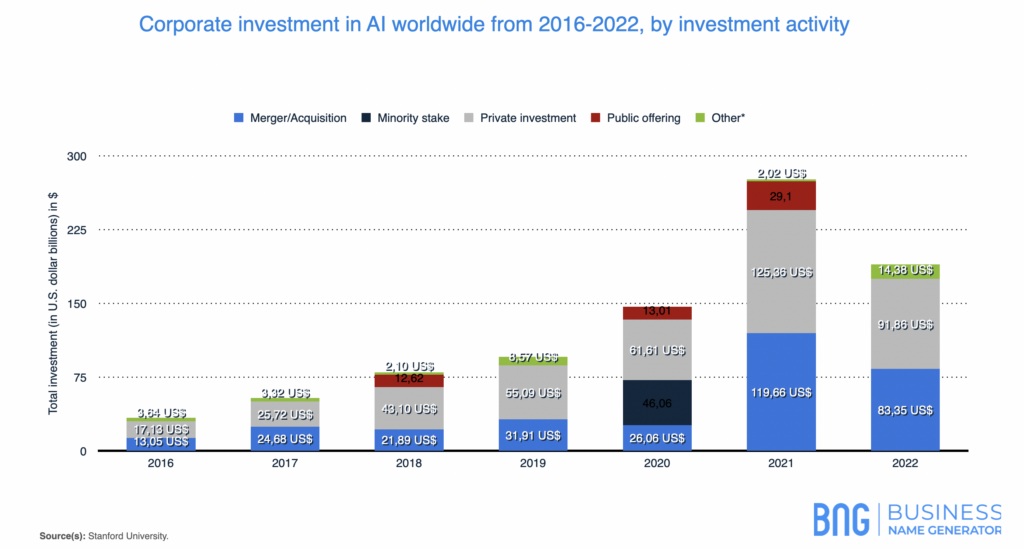
Who are the market leaders in artificial intelligence?
The major contribution to the number is the acquisition of companies (and technologies) from bigger corporations. Google, Facebook, Amazon, Microsoft, Apple — all the big hitters are investing heavily in AI-based companies.
What makes it interesting is that not only tech giants are involved in the artificial intelligence market share. AI has found its way into various industries, such as automotive, healthcare, manufacturing, finance, and retail. Starbucks, for example, uses its Deep Brew program to automate inventory management and reduce waste by predicting the right amount of ingredients.
Artificial Intelligence Market Size
How big is the artificial intelligence market?
Currently, the global artificial intelligence market size is projected to reach $305.90 billion at 2024. During the forecast period of 8 years, we should expect to witness significant growth.
Is AI a trillion dollar market?
Experts expect the market size to hit the $1-trillion mark sometime in 2028.
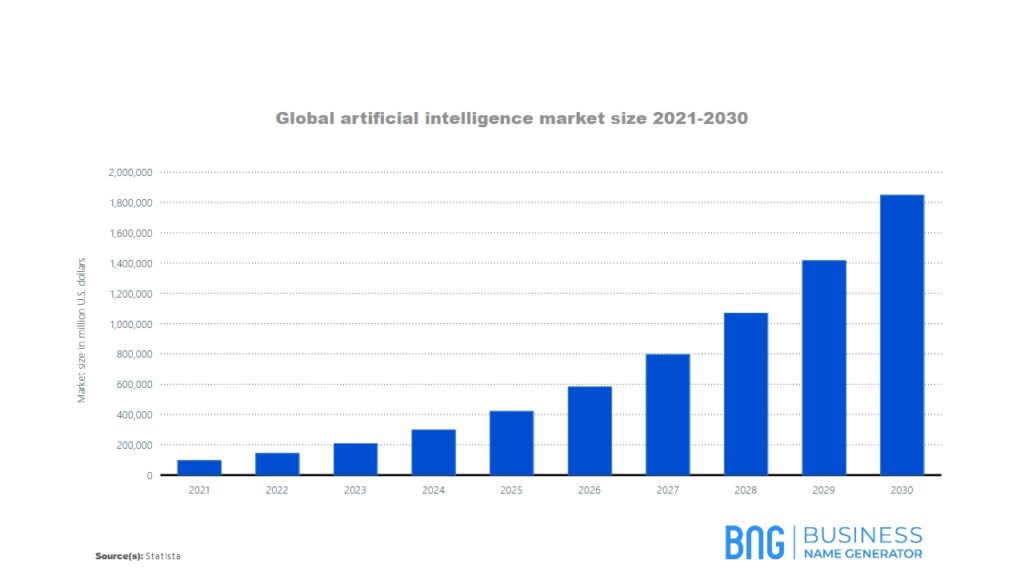
While these numbers seem impressive, bear in mind that AI is still in its development. Another important aspect to factor in is the fact that AI technology spans various industries, making it more difficult to quantify its actual worth.
Artificial Intelligence Market Growth
What is artificial intelligence and its market?
Today, it’s become hard to distinguish between AI and complex software that isn’t artificially intelligent. The term artificial intelligence refers to any machine or system that mimics human thought processes and is based on three skills:
- Learning: AI models gather data and create algorithms for how they can use the data to turn them into information.
- Reasoning: The program has a plethora of algorithms to choose from and needs to pick the right one to get the desired result.
- Self-correcting: AI models continually revise themselves and fine tune their algorithms to provide optimal results.
For an AI model to be successful, it needs huge volumes of data as it can only work with what it “knows.” This makes artificial intelligence complex and often expensive. The major advantage is that, once provided with necessary resources, it can deliver results consistently and work on optimization independently.
Although we’re yet to feel the full extent of AI and its possibilities, the market has already shown us how it can develop and affect virtually all industries. One of the major growth factors comes from the fact that big corporations are investing heavily in the research and development of various tools and services.
For example, some of the affected industries include:
- Logistics,
- Automotive,
- Retail,
- Food and beverages,
- Manufacturing,
- Banking,
- Technology development,
- Healthcare,
- Shipping,
- E-commerce,
- Cybersecurity,
- Data analytics.
With cloud computing, automation, and 5G deployment developing independently, we’re likely to see these functions converging together and increasing the demand for AI-powered solutions.
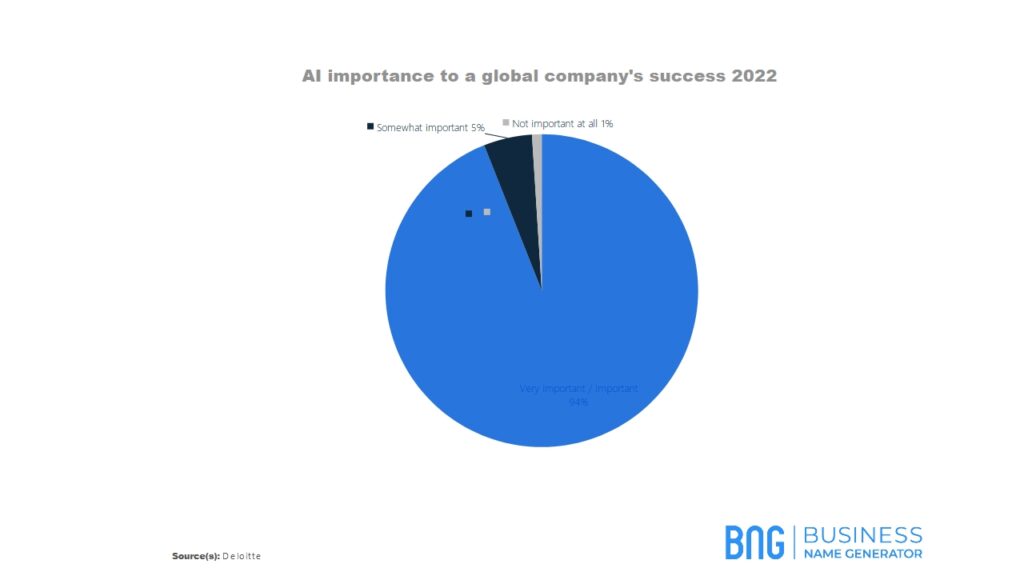
According to a survey by Deloitte, a whopping 94% of all business leaders expect AI to be one of the most important aspects of their businesses, regardless of the industry they’re in.
ChatGPT User Growth
One of the most popular examples of AI use is OpenAI’s ChatGPT. ChatGPT has seen rapid user growth since its launch, with an increasing number of people turning to the platform for help with a variety of tasks, from creating creative content to seeking advice on a wide range of topics.
What is ChatGPT?
ChatGPT is a natural language processing tool (chatbot) that uses large language models and internet databases to find answers to users’ queries. These answers are not purely factual — you can use ChatGPT to do a variety of tasks.
While not the first chatbot ever, ChatGPT changed the way we perceive AI technology and made it obvious that AI-powered tools are on the brink of replacing current technology and many forms of manual labor.
How many users does ChatGPT have?
According to the latest research, ChatGPT has around 180.5 million users. If you look at the below graph, it’s obvious ChatGPT has managed to do something remarkable when it was launched.
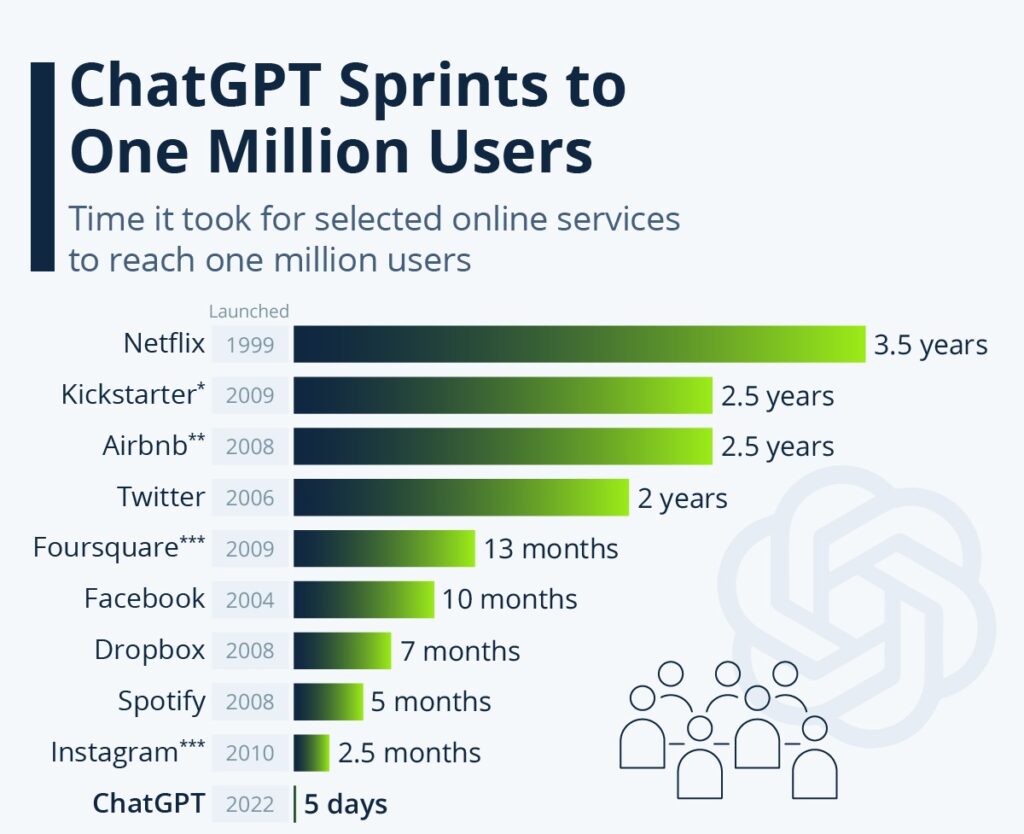
Artificial Intelligence Trends 2024
In the past, AI development has focused on the advancement of logical reasoning, as well as mathematical and linguistic abilities. Google’s DeepMind, an AI research laboratory, has developed a feature that allows AI models to learn multiple skills.
One of the major changes in AI trends is developing models that are able to comprehend the physical world and develop emotional intelligence.
Aside from developing emotional intelligence, other trends in AI development include:
- Sequential learning,
- Deep learning,
- Transfer learning,
- Reinforcement AI,
- Growth in hardware and software development.
Artificial Intelligence Competitor Analysis
The current blueprint for succeeding in the AI space is to develop an AI model, provide proof of concept, and land an important investment from one (or more) of the big corporations. With the investment reaching over $90 billion in 2021 alone, all you need is an AI system that works and a catchy AI business name.
Some examples of AI systems include:
- NuraLogix: Uses machine learning and transdermal optical imaging to observe blood flow and reveal hidden emotions. According to the company, its AI model is more accurate than a polygraph.
- Drive.ai: Programs vehicles to recognize people and items in the environment, as well as interact with the driver.
- Affectiva: Works with over 1,400 brands worldwide to assess the emotional effects of advertisements.
- Beyond Verbal: Analyzes vocal intonations to decipher emotions and help marketing professionals to improve customer experience.
Artificial Intelligence Revenue Comparisons
As we’ve seen, the artificial intelligence market has been receiving heavy investments in the past few years and will continue to do so. Obviously, such investment is backed by current and projected revenue.
If we focus on North America alone, experts expect the revenue from the AI market to reach $128.8 billion in 2028.
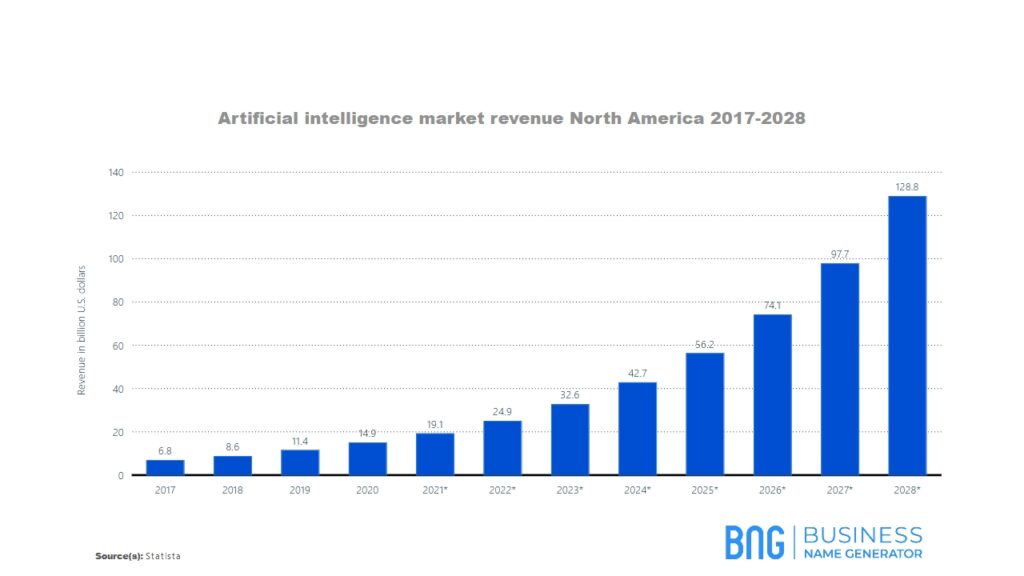
This will have a significant impact on the global economy, affecting various industries at once. In 2030, the projected increase in GDP due to AI is as follows:
- Public and personal services: 20.5%,
- Consumer goods, accommodation, and food services: 15%,
- Technology, media, and telecommunications: 13.5%,
- Manufacturing and construction: 11%,
- Transport and logistics: 10.5%,
- Energy, utilities, and mining: 11%,
- Financial and professional services: 10%.
AI-based revenue can also have an aggregate economic impact on various industries. For instance, experts claim retail businesses will see a rise between $400 and $800 billion. On the lower end of that scale, we have agriculture and pharmaceuticals, with an expected revenue increase of $100 and $200 billion.
According to some studies, global AI revenue should be well over $1 trillion in 2030.
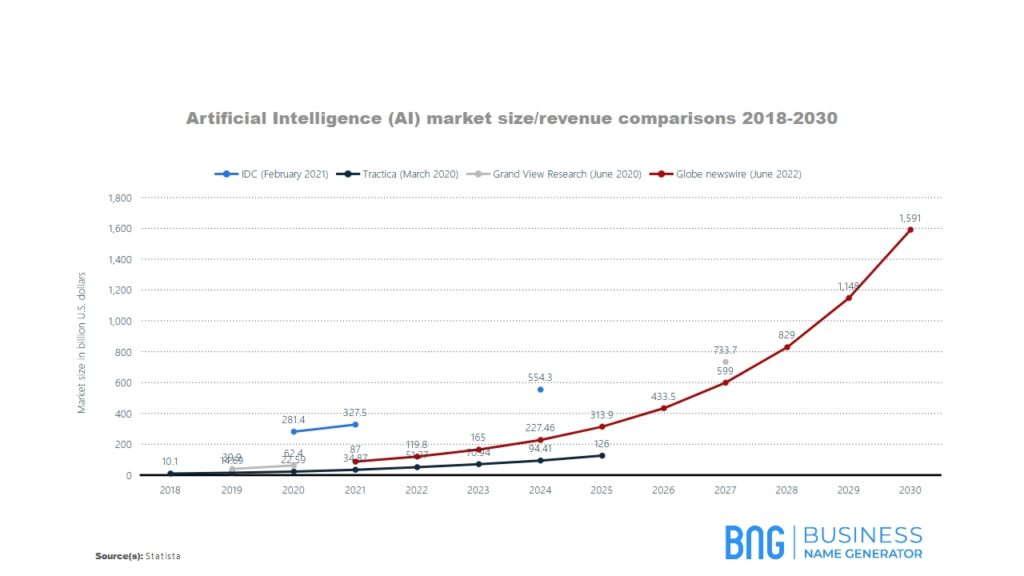
Artificial Intelligence in Marketing
One of the main beneficiaries of AI development is the marketing industry. It has allowed marketers to create content via software, automate processes, and predict customer behavior.
The market value of artificial intelligence in marketing should be over $100 billion by 2028 according to projections.
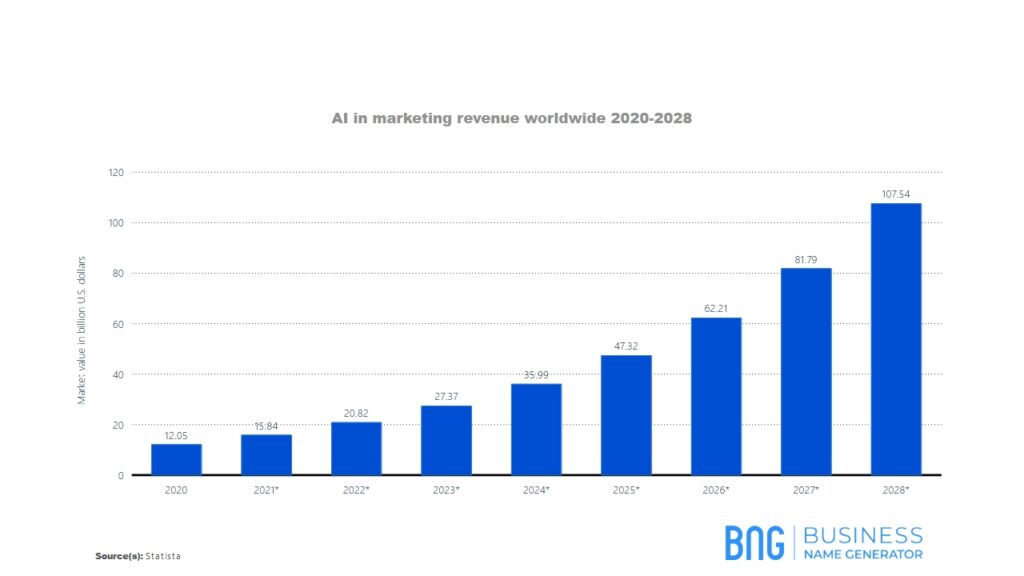
The expectation of professional marketers is that AI help them in many aspects of their work including:
- Targeted ads,
- Personalized content,
- Real-time offers,
- Conversion probability calculation,
- Email marketing optimization,
- Live chat sessions,
- Lead scoring,
- Copywriting,
- User experience improvement.
Currently, AI in marketing focuses on user experience and customer journey. It might come as a surprise to some that the main usage of AI is aimed at automating customer interaction and personalizing the customer journey across channels.
This allows marketing companies to offer unique experiences to their customers without having to devote their time to each individual.
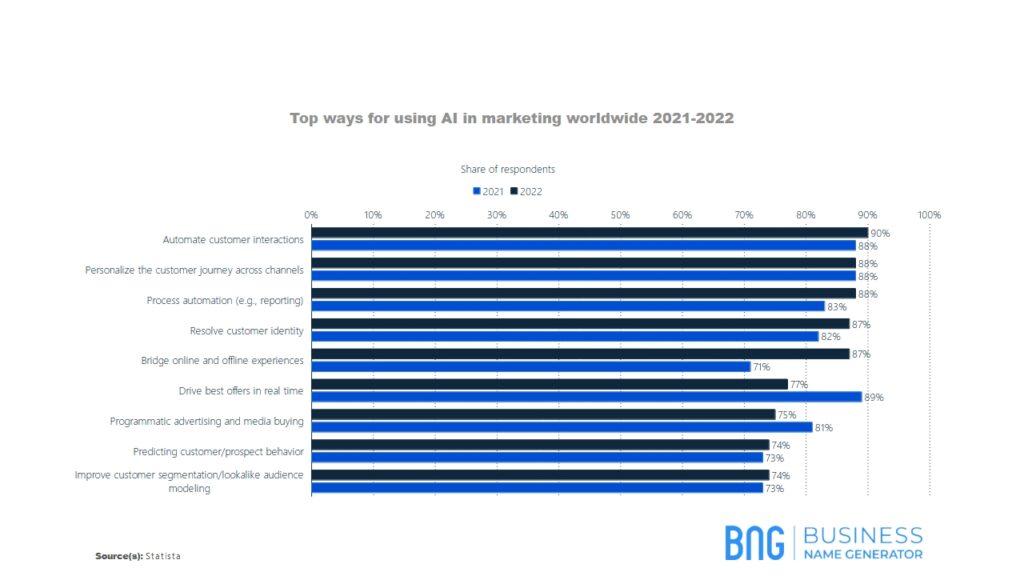
Artificial Intelligence by Geography
Currently, the leader in AI development is China, followed by the United States. This doesn’t mean that other countries are idling behind, with Singapore and the United Kingdom having some of the world’s most AI-driven cities.
Despite being the second in AI development, the United States has trouble getting people to accept the implementation of AI. India is the leader in this aspect.
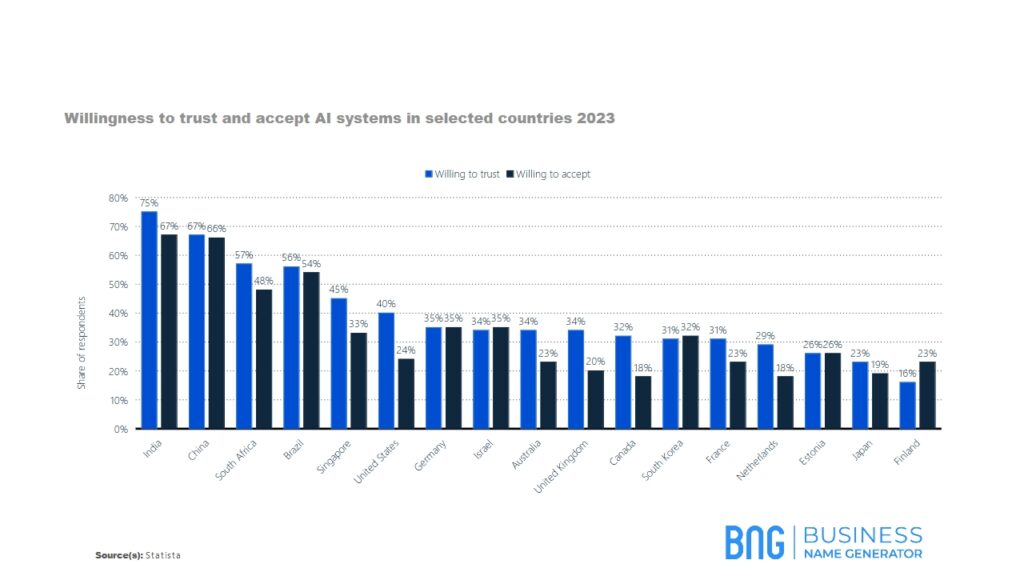
Here, we’ll break up the artificial intelligence market by regions and countries:
- China,
- United States,
- Europe.
China
In 2022, China’s AI market was valued at around 272.9 billion yuan (around $40 billion). However, the actual size of China’s AI economy is different. Depending on whether you want to look at companies with AI as its core industry or all AI-driven industries, Chinese companies’ worth goes over $1 trillion yuan. In 2026, the forecast for China’s AI economy suggests that all AI-driven industries will amount to over $2 trillion yuan ($145 billion).
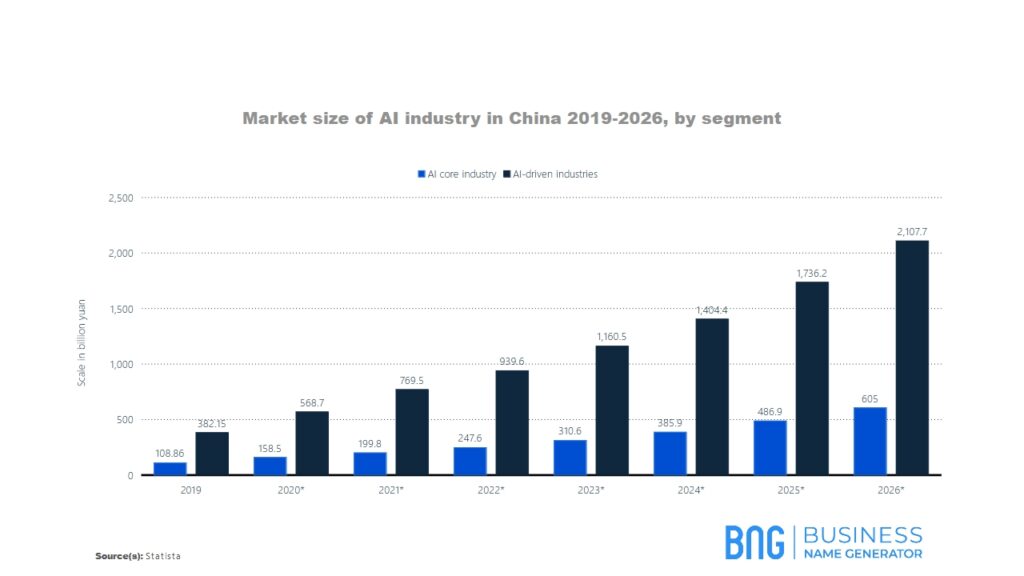
Chinese companies are also leaders in AI patent holding, with Tencent and Baidu being the most prominent corporations in this field.
United States
As we’ve already established, the North American AI market has significant traction, with revenue expected to go over $120 billion in 2028. While everyone is still warming up to the idea of using AI in everyday life and across all industries, companies are not waiting around and are making heavy investments.
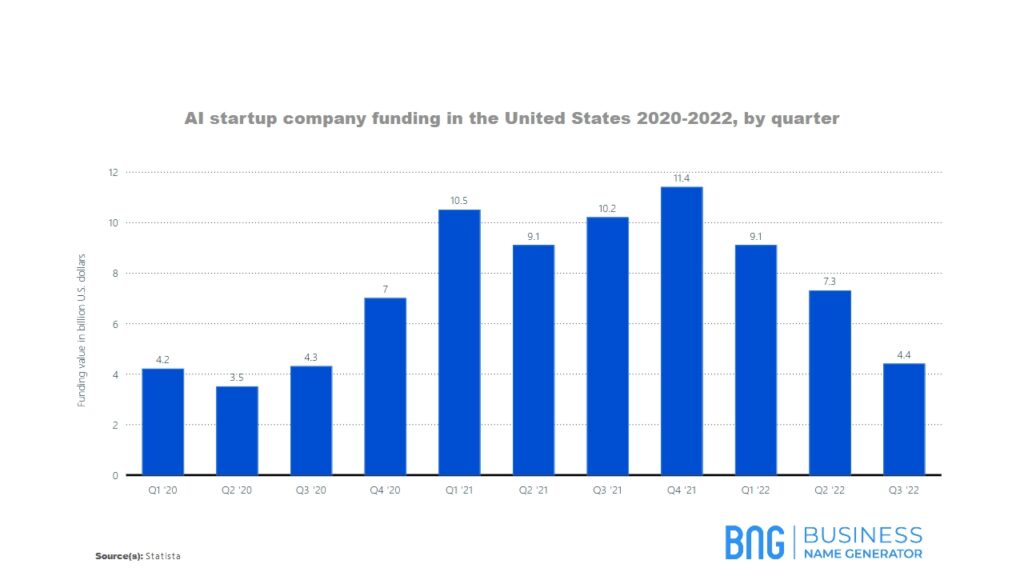
Europe
Europe is slightly lagging behind China and North America. AI-based companies are not as plentiful, and they usually attract investment and acquisitions from U.S. corporations. The United Kingdom is the leader in AI development, followed by Norway and Spain.
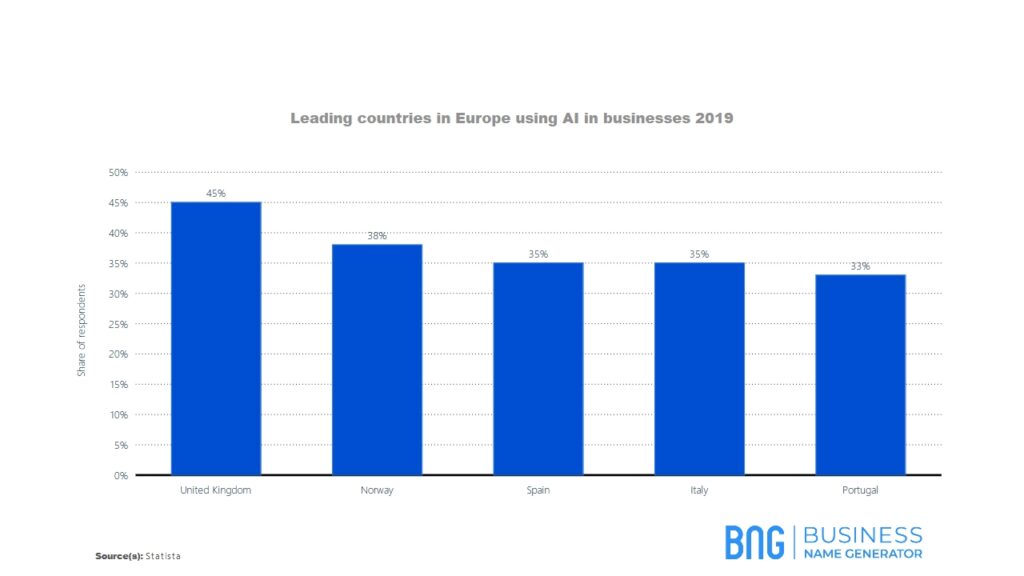
Artificial Intelligence by Industry
As we’ve already established, AI has found its way into a variety of industries and has a major impact on different markets. The most used features of AI are robotic process automation and computer vision, comprising over 70% share.
We’ll go over different types of AI models and see how much revenue they produce.
Machine Learning
When it comes to machine learning, OpenAI is the undisputed leader in this category, thanks to the success of ChatGPT. Machine learning represents AI models that use advanced algorithms and databases to get better at predicting outcomes. For instance, ChatGPT logs all interactions on its platform and provides better answers the second time of asking.
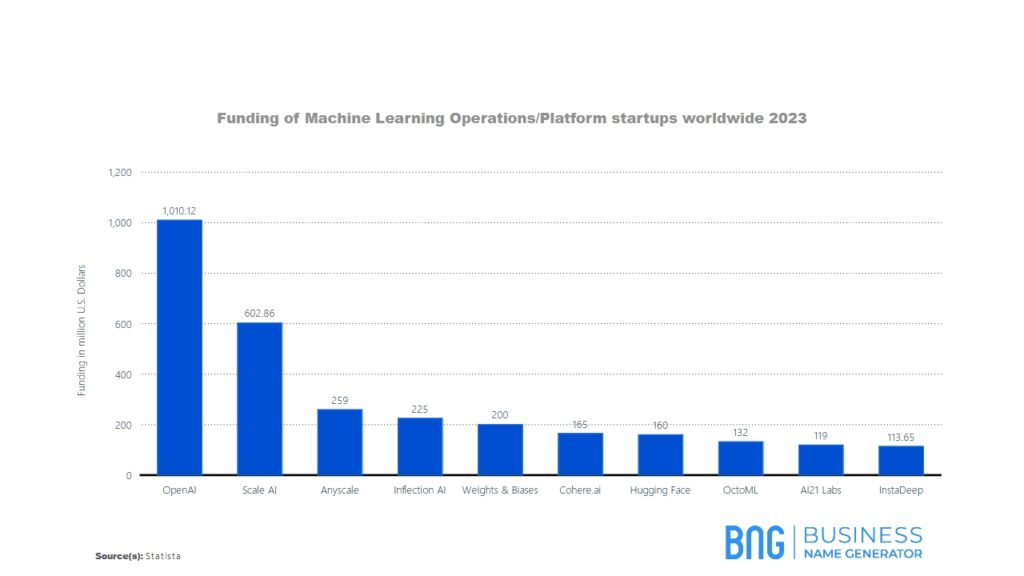
Generative AI
Generative AI is any AI model that can produce some type of content. This can be imagery, text, audio, or any other synthetic data. Various industries use generative AI, with marketing and advertising leading the race.
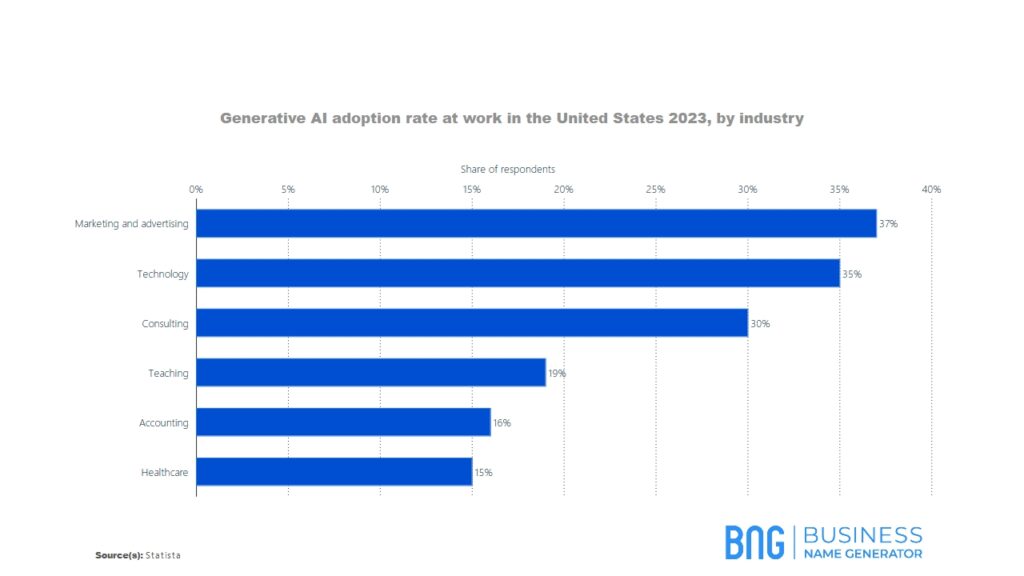
One of the aspects of generative AI is the ethical side of it. Many dispute the use of AI-created content on the internet and in the workplace. Since it’s in its early stages of development, we can expect many regulations yet to be introduced regarding these AI models.
Healthcare
Healthcare is one of the most interesting industries that AI has affected. Hospitals use AI for preventive care, better diagnoses, enhancing the quality of life, and other aspects of patient care. Over 90% of healthcare organizations claim to have an AI strategy, with over 60% of them being familiar with robotic automation processes.
AI’s contribution to the healthcare market currently sits at about $20 billion. Experts expect a rapid rise, with that number going to just under $190 billion in 2030.
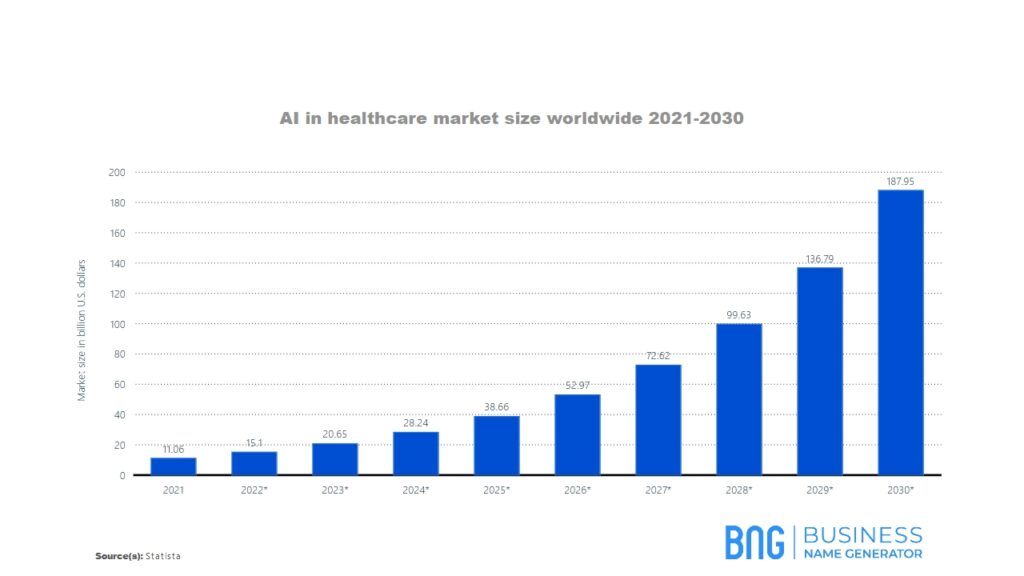
Robots
The first time any of us heard about AI, we imagined evil robots taking over the world and Tom Cruise having to save us all. AI has not gone that way (yet!), but we do use AI-powered robots and robotics in various industries, mostly in manufacturing.
The global AI-led robots market is still undeveloped and comparably smaller to healthcare, although it’s expected to grow substantially by the end of this decade.
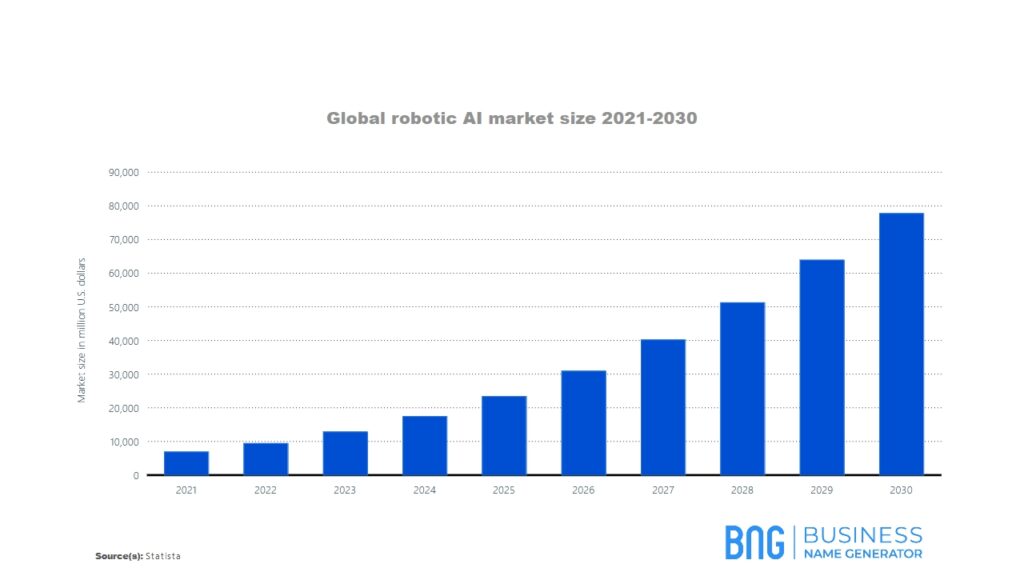
Key Takeaways
Whether we like it or not, artificial intelligence has arrived, and it’s here to stay. While it’s still early in its deployment, it has already affected dozens of industries and will only continue to do so.
The global artificial intelligence market is on a constant rise. More and more companies are utilizing AI to optimize their business models, even if they’re not directly connected to technology or advanced algorithms.
By 2030, the AI market size will reach over $2 trillion. If you want a piece of that pie, better start early and get your seat at the table. Developing an AI model requires years of research. Once you’re finally ready to go public with your AI-powered tool, you’ll need a name for your startup that people will cling on to. Use our AI business name generator to get the best ideas fast.